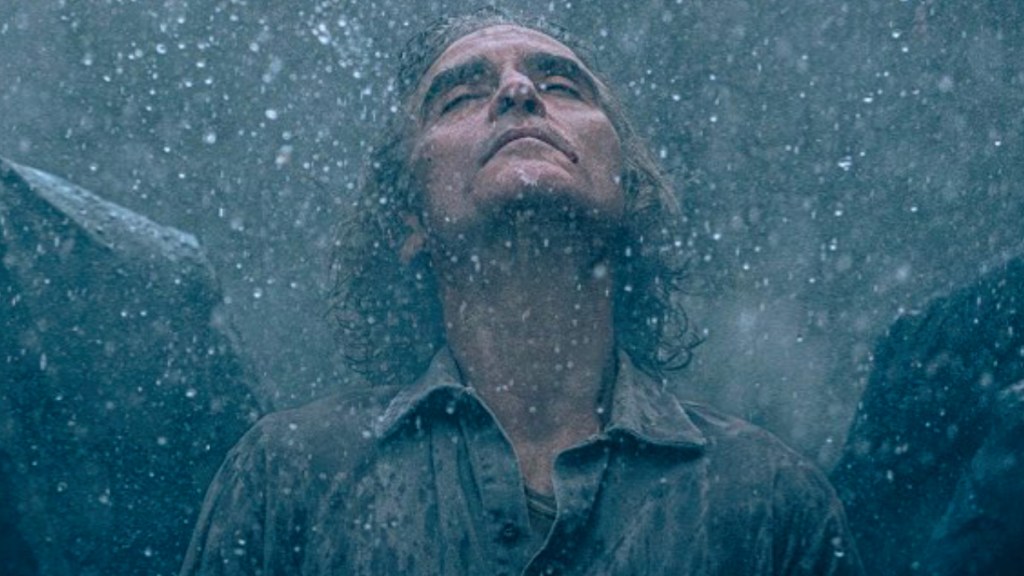Joker: Folie à Deux is the concluding chapter of the story of Arthur Fleck (Joaquin Phoenix), and the movie features an ending that is definitive. However, the final scene has drawn a wide range of reactions from viewers, with many speculating that it connects the movie to Christopher Nolan’s The Dark Knight and Heath Ledger’s Oscar-winning outing as the Joker.

New Joker 2 theory puts Heath Ledger’s Joker in Folie à Deux
Toward the end of Joker: Folie à Deux, a guard at Arkham informs Arthur that he has a visitor. As Arthur goes to see who it is, an inmate stops him. We never get this individual’s name in the movie. Portrayed by Connor Storrie, the character is simply credited as Young Inmate. He tells Arthur a joke about a psychopath and a famous clown, before stabbing the other man repeatedly, effectively underscoring who is who between the two of them. Arthur dies while the inmate laughs and carves out a Glasgow smile on his own face.
This scene has led to a fan theory speculating that this unnamed inmate is the younger version of the Joker from The Dark Knight. In that movie, Heath Ledger’s character has similar scars. He tells at least two different stories about how he got it. In one, his abusive father gave it to him while saying, “Why so serious?” and “Let’s put a smile on that face.” According to the second, the Joker mutilated himself after gambling sharks gave a Glasgow smile to his wife, and he wanted to assure her that he didn’t care about the scars. Given who the Joker is in the movie, either can be true or neither. But, according to the above-mentioned fan theory, a younger version of the Joker from The Dark Knight gave himself that bloody smile after killing Arthur.
Who was the inmate who killed Arthur Fleck in Joker 2?
There are multiple problems with the theory of this inmate being The Dark Knight’s Joker. Some of the main ones among them are the continuity issues. For instance, Harvey Dent sustains severe injuries on one side of his face when a car bomb goes off outside the courthouse. He may not be as severely disfigured as comic iterations of Two-Face or even Aaron Eckhart’s version of The Dark Knight.
However, we must remember that Todd Phillips has created an extremely grounded world in these movies. The physical transformation that Harry Lawtey’s Harvey Dent goes through is probably enough to be part of his transition to Two-Face in this setting. And if that’s the case, this movie doesn’t fit as an origin story for Ledger’s Joker because Dent’s disfigurement is an important aspect of The Dark Knight’s plot.
Moreover, Nolan’s The Dark Knight Trilogy seems to take place in modern times. Batman Begins came out in 2005, and The Dark Knight Rises in 2012. Ledger was in his mid-to-late 20s when he filmed his scenes as the Joker. Even if the Joker was a few years older than the actor portraying him, he would still be too young to be Arthur’s killer in Joker: Folie à Deux, which is reportedly set in 1983.
Considering all this, it’s unlikely that the Young Inmate is the Joker from The Dark Knight. However, he can be the Clown Prince of Crime in Phillips’ world. After all, Phillips has made it clear that Arthur is not a “criminal mastermind.” Following Arthur’s testimony, the inmate sees Arthur as just another victim of society, someone who deserves his scorn and not his adoration.
By fatally wounding Arthur and mutilating himself, the inmate all but co-opts the Joker identity for himself. As a result, while Arthur dies, the legacy of Joker lives on in a more terrible and truly anarchic avatar.










